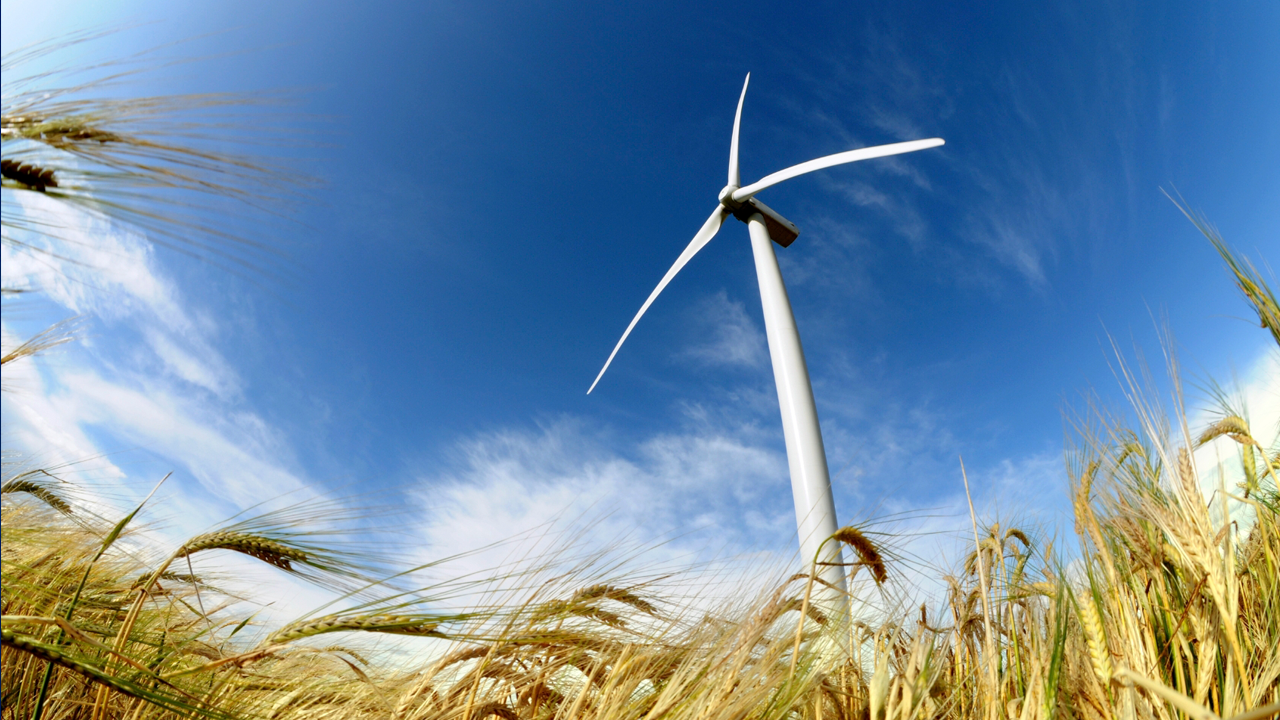
Minnesota farmers send more than $400 million a year out of the state to buy nitrogen fertilizer, most of which comes from outside the U.S. and leaves a hefty carbon footprint.
Now, a team of researchers from across the University of Minnesota has set out to develop a cleaner, more sustainable alternative. Their recipe relies on three abundant resources: air, water and wind.
Coming together under a single project, these researchers are developing a new, wind energy-based production method that allows Minnesotans to produce and purchase renewable fertilizers locally. Their project is part of MnDRIVE (Minnesota’s Discovery, Research and InnoVation Economy), an $18 million annual investment by the state of Minnesota that aims to solve grand challenges in four key areas: robotics, sensors and advanced manufacturing; global food ventures; advancing industry, conserving the environment; and discoveries and treatments for brain conditions. As part of MnDRIVE’s Transdisciplinary Research Program, the sustainable fertilizer project will bridge several of these areas, bringing together experts from across the U to meet farmers’ demand for fertilizer while vastly reducing the carbon emissions released during production.
Michael Reese, renewable energy director at the University of Minnesota’s West Central Research and Outreach Center (WCROC) and lead principal investigator on the project, said there is a pressing need for sustainable fertilizer. Right now, farmers add nitrogen to the soil by churning, or “knifing” in, ammonia gas. Ammonia production is typically fueled by natural gas and coal, which release environmentally harmful carbon dioxide. With European and U.S. markets increasingly requiring food suppliers to reduce their carbon footprint, farmers are looking for ways to cut emissions out of the equation.
“Farmers need tools they can use to do that,” Reese said. “Whether they’re growing grains for food or for feed, nitrogen fertilizer is an essential part of the process. They are always looking for ways to make this process more efficient, safe and cost effective.”
There’s also an economic toll to importing fertilizer: Minnesota’s farmers are sending money out of the regional economy.
Faced with finding solutions to these challenges, Reese and other experts turned to wind energy, a resource readily available in the same regions of the state where farmers need to fertilize their crops. Wind power can fuel the process of removing hydrogen from water, while a separate process extracts nitrogen from air. Running hydrogen and nitrogen through a chemical reaction can take the two elements and form ammonia (NH3).
The project aims to study how well several small production plants could serve Minnesota’s fertilizer needs, and along the way, overcome challenges endemic to ammonia fertilizer plants. Typical plants are very dangerous, as they handle explosive materials and operate at high pressures. Edward Cussler, Ph.D., professor of chemical engineering and materials science at the U’s College of Science and Engineering and a researcher on the project, said existing methods of synthesizing ammonia are also extremely inefficient, only converting about 20 percent of the materials put in. The resulting ammonia then has to be cooled to separate it from the materials that did not react, which have to be put through the process all over again.
Using his expertise in chemical separation, Cussler is designing a system that operates at the same pressure as a bicycle tire — a safer level that is about 10 percent of the pressure currently used — and that does not require cooling. Through the use of magnesium chloride, an inexpensive additive, he estimates the system could reach as high as 99 percent efficiency. Alon McCormick, Ph.D., an expert in catalysts who is also in chemical engineering and materials science, is working alongside Cussler to keep the reaction moving fast, so efficiency does not come at the cost of speed. The project will be the first to incorporate both a catalyst and a separating agent in ammonia production.
Many experts, one project
The project brings together experts from a wide variety of disciplines to develop new technology, drawing in researchers from chemical engineering and material sciences, bioproducts and biosystems engineering, and the U’s BioTechnology Institute. But it will also take expertise in applied economics, policy and agriculture to understand how best to implement it and make it accessible to the state’s farmers and companies.
At WCROC, Reese is now running a pilot plant that uses electricity generated from a wind turbine to create nitrogen fertilizer using the industry-standard method. (Only about 10 percent of the wind turbine’s energy is used for ammonia production.) The plant will allow his team to collect data to serve as a point of comparison for the new system’s efficiency.
While others are ensuring the new system is highly functional, collaborators like Doug Tiffany, an applied economist from the U’s Extension Service, and Prodromos Daoutidis, Ph.D., a professor of chemical engineering and materials science, will make sure actually putting it into use is practical from an economic standpoint. Tiffany, for example, will develop an economic assessment to forecast the system’s impact on farmers, companies and distributors. Meanwhile, Steve Kelley, a former Minnesota senator and a Humphrey School of Public Affairs senior fellow, will examine the policy implications of putting the system in place.
As they look to tackle the grand challenge of producing sustainable fertilizer, the researchers involved have derived new — and sometimes serendipitous — inspiration from collaborating across a wide range of disciplines.
“The intellectual synergy is completely random,” Cussler said. “It comes at times when you least expect it.”
Learn more about this and other transdisciplinary research projects and see a complete list of project participants.